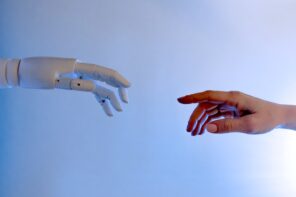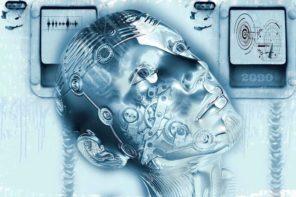Diane Winston________________
Missed last week when I was traveling in Israel and the West Bank with my journalism class. Caprica wasn’t aired where I was; neither could I download it. But its themes were present in the “othering,” religious extremism, ethnic tension, violence, and gender performances that constitute everyday life in the region. Fact is an adrenaline rush, but fiction has better sets and costumes.
If you want to know about the real deal, my post is here and the students’ here. As for Caprica, othering is so pervasive that it constitutes the basis of most relationships. Capricans other Taurons, polytheists other monotheists, and Sam Adama others anyone he has to kill. Likewise, gender performances belie the easy androgyny that marked BSG. In Caprica, masculinity is the exercise of controlled power. Tomas Vergis is a pro, Joe Adama a wuss, and Special Agent Durham remains a question mark. Women rely on seduction and subterfuge. In “Ghost in the Machine,” Clarice beguiles Amanda, the Zoebot smooches with Philomon, and Lacy works to win over Keon.
But the nub of othering and masculinity is enacted in Daniel Greystone—and is displayed in his interaction with the Zoebot. What fascinated me in BSG (and impelled me to watch Caprica) is the exploration of the question “what makes us human?” If a provisional answer, and one that is supported by both series, is the ability to empathize with another’s suffering, then I am uncertain about Daniel’s humanity. His belligerent approach to the Zoebot—is she or isn’t she his offspring?—is offputting. Testing her with a ring of fire is almost unbearable; commanding her to shoot Cyrus is indefensible. What child could claim a parent whose love comes wrapped in malevolence? Or could it be that Daniel, seeing a robot rather than his flesh-and-blood child, cannot extend the assumption of full humanity to the gleaming machine that towers above him.
I admit to being flummoxed by Amanda. By my own definition, she comes closer to humanity than does her husband. But as she singlehandedly stops the removal of the Maglev memorial, her overabundance of feelings for the victims and their mourners veers into madness. As of now, the subplot about her dead brother seems headed down a rabbit hole, but I am willing to extend the benefit of the doubt to the show’s writers. Hopefully this is a better twist than what the folks at 24 have concocted for the formerly hard-bitten Kara Thrace. As for the Zoebot? It’s easy to imagine this is truly Zoe Greystone, but the avatar’s commingled cylon consciousness has rendered it a new creation. Is it human or something new and other? Maybe Daniel’s search for his daughter is futile: she no longer exists.
Henry Jenkins________________
I have always been fascinated by the Voight-Kampff Test in “Do Androids Dream of Electric Sleep?”/Bladerunner. Philip K. Dick describes it as an empathy test—one executed to try to distinguish between humans and replicants. Yet he never makes clear whether it is the presence or absence of empathy which makes one a replicant. The film in particular depicts a world where humans have lost much of their humanity, the very trait which the androids have sought to acquire. They hold desperately to life, even as human seem to hold it largely in contempt. It is certainly possible in such a world that empathy is what sets machines apart from humans rather than the other way around.
This issue resurfaced for me as I was watching this week’s episode and trying to make sense of what’s up with Daniel “Daddy Warbucks” Graystone and his ongoing “testing” of the Zoebot. Early in the series, we were tempted to see him as a grieving father who was willing to do anything to recover his daughter; yet here, rather than nurturing the machine he thinks contains his daughter’s electronic footprint/soul, he instead uses everything he knows of his daughter (her fears, her childhood traumas, her loves, her ambitions) to try to assert his control over her, to try to force her to speak her truths from deep within the depths of the machine. He has become her terrorist, her torturer, her tormentor; yet in the process, she has been discovering her contact with the machine, relying on what the machine knows (such as the weight of the gun with a blank vs. with a bullet) to survive the way her father deploys what he knows about her.
It feels like we are witnessing the personal trauma which might ultimately set the cylons against the humans: originating not in the inhumanity of the machine, as we were first presented with the war at the origins of Battlestar, but at the inhumanity of the human. And of course, there is an obvious connection going on here to the riddling competition which is being staged inside the game world of New Cap City as the cross-dressing MC tests the mettle of Daddy Adama, consistently defends Tamara’s honor and memory against the kind of “sick game” that Daddy Graystone is subjecting the Zoebot to in cross-cutting scenes.
I particularly loved the scene between the two Adama brothers this week. Sam’s discussion of what allows him to kill in cold blood—that he can mentally turn his foe into “targets” and convince himself that he is playing a game—really sets up the contrast with New Cap City, where it would seem you can win only by convincing yourself that this is not a game but has a brutal reality where everything is at stake even as everything is permitted. There’s a lot going on here with the concept of the “magic circle” which I’ve raised here several times now. The “magic circle” is that mental frame which allows us to play games, put ourselves into them with intensity, and still suspend real-world consequences of our actions within the game. In a sense what Sam is telling us is that he forces himself to construct a “magic circle” around the real-world violence in his life, convincing himself that it is not real and that it thus has no consequences. On the other hand, his brother, upon entering New Cap City, has to accept the game’s reality as the only reality that matters, suspending the morality that prevents him from embracing the violence of Tauran masculinity in the real world, and becoming as ruthless as he needs to be to find the truth. For me, Caprica is becoming as much about the fluid borders between games and reality as it is about the boundaries between human and machine— both are key questions for our time.
One last thought: I am really intrigued by Tamara’s mark, which she leaves on the walls of New Cap City. In some ways, it is a continuation of the tattoos that we’ve discovered are so central to Tauran culture—a set of marks through which we negotiate between our identities and our histories. But we can also see it as the opposite of the tattoos. It looks like Taurans use tats to mark their social identities onto their bodies, while Tamara seems to use the mark to leave a trace of her personal identity upon the physical, external world. But given the ways the other players are responding to her—as a figure of mystery, as a traveler between worlds, as the unlocker of secrets—how long before her personal mark becomes a religious icon of some kind?




